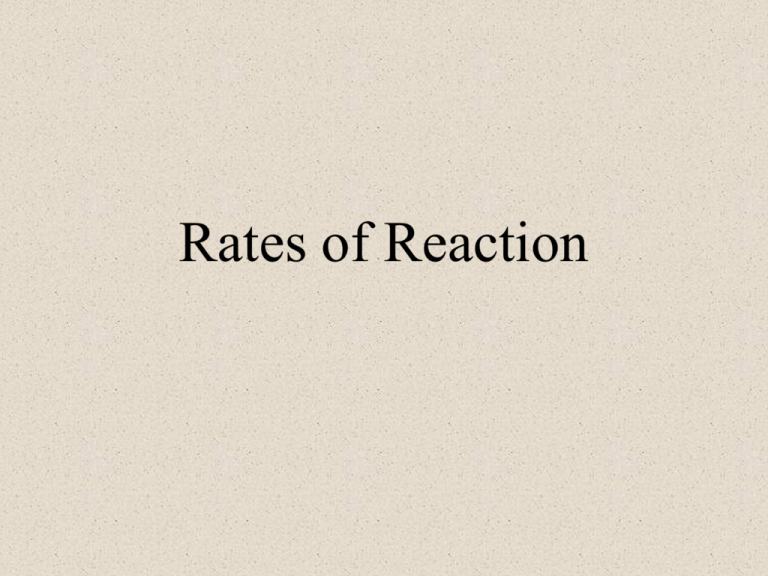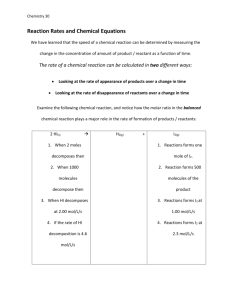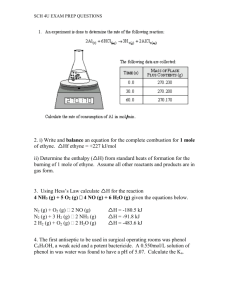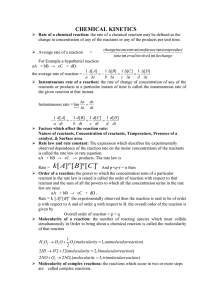PowerPoint - Rate of Reaction - Factors, Examples
advertisement

Rates of Reaction • Read 18.1 pg. 737-738 • Demonstration of variations in reaction rates: Ca vs. Na vs. Li in water to produce H2 gas Flour burning in air 8H+ + C2O42- + MnO4- Mn2+ + 4H2O + CO2 H2SO4, H2C2O4 (oxalic), KMnO4 provide ions • From the list predict the fastest (1) to slowest (4) 0.5 M 1.0 M water Other oxalic acid H2SO4 a 2.5 mL 2.5 mL 5.0 mL b 2.5 mL 2.5 mL 5.0 mL at 60C c 2.5 mL 2.5 mL 5.0 mL + manganous sulfate d 2.5 mL 5.0 mL 2.5 mL Examples of factors affecting rate • Read 18.2. For each of the 5 factors give one example from today’s demonstrations • Nature of reactants – • Ability of the reactants to meet – • The concentration of the reactants – • The temperature of the system – • The presence of catalysts – Examples of factors affecting rate • Nature of reactants - Na is more reactive than Ca (it more easily loses its outer electron) • Ability of the reactants to meet - Flour burns faster as a fine powder because oxygen surrounds it (heterogeneous reaction?) • The concentration of the reactants - reaction d has a higher H2SO4 (reactant) concentration, and thus reacts faster; flour + pure O2 • The temperature of the system - reaction b is faster due to an elevated temperature • The presence of catalysts - manganous sulfate (reaction c) is a catalyst for this reaction Measuring Reaction Rates Read 18.3 (740 – 42). Answer these questions: 1. What units are associated with concentration? 2. What units are associated with reaction rate? 3. What do the square brackets in [HI] indicate (see figure 18.2, pg. 741) 4. Explain how the rate of a reaction is determined (see fig. 18.2)? 5. Plot this data (include title, axes labels): [HI] 0.100 0.072 0.056 0.046 0.039 0.034 0.030 0.026 Time (s) 0 50 100 150 200 250 300 350 Measuring Reaction Rates 6. For the data, determine the rate of reaction at i) 25 s, ii) 175 s, and iii) 325 s. Show your work and calculations on the graph. 7. How does the rate at the beginning of a reaction compare to the rate later in a reaction? Explain why this makes sense according to one of the 5 factors that affect reaction rates (from 18.2)? 8. Explain how the rate of reaction of 2HI H2 + I2 is determined experimentally. 9. Do PE 2 (pg. 742) Measuring Reaction Rates 1. Concentration: mol/L or mol•L–1 2. Rate = concentration/time: (mol/L)/s or mol•L–1•s–1 3. The square brackets "[ ]" is the symbol for concentration (mol/L) 4. The rate of reaction is measured by: Instantaneous slope; rise over run; slope of the tangent at any point. 4, 5, 6 Concentration HI (mol/L) 0.12 Graph of [HI] vs. Time 0.10 0.08 rise run 0.06 0.04 0.02 0.00 -50 0 50 100 150 200 250 300 350 400 Time (s) Slope (rise/run) is the reaction rate in (mol/L)/s… Measuring Reaction Rates cont 6. i) rate (0.100-0.072)/50 = 0.00056 (mol/L)/s = 5.6 x 10-4 mol•L-1•s-1 ii) rate 1.4 x 10-4 mol•L-1•s-1 iii) rate 0.8 x 10-4 mol•L-1•s-1 7. As the reaction proceeds, the rate decreases because reactants are being used up (recall, concentration of reactants affects rate) 8. HI concentration is measured indirectly by measuring the production of I2(g) (purple) – likely via a spectrometer 9. N2O4 2NO2, NO2 forms at 0.010 mol•L-1•s1, thus N O decomposes at 0.005 mol•L-1•s-1 2 4 For more lessons, visit www.chalkbored.com




![[SO2]2[O2] [SO3]2 524.4K• 462.9K• 8.314 J mol•K • ln125.4 61.5K](http://s3.studylib.net/store/data/008432217_1-f6f0ddc631a0ec89f84a5e786b3339ef-300x300.png)




